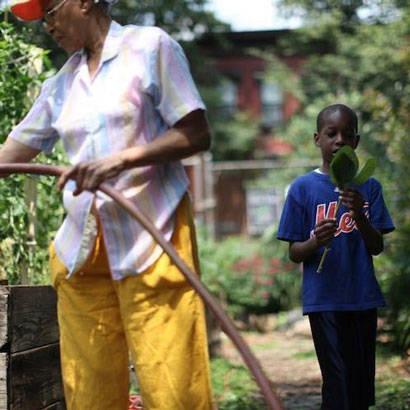
The 462 Halsey Community Garden is a robust, volunteer-run farm where residents grow more than just food. Alice Forbes Spear, a volunteer, describes the garden’s model as “growing food, but also growing community.” The formerly vacant lot is nestled in Bedford-Stuyvesant, Brooklyn (New York) — a culturally vibrant, yet historically underserved community. In the fall of 2011, a group of volunteer community residents rallied around the long-empty 462 Halsey Street lot, and by the spring of 2012, those stewards opened the community garden’s gates, which stay open all day, every day, from April through October. By the beginning of 2014, the community garden group abandoned its private allotment system in favor of a communal growing model (with a few garden beds reserved for long-standing and elderly residents) as a way to increase garden membership and more efficiently use the small space bounded by four apartment buildings.
Now, 462 Halsey is one of 60 community gardens that provide lush green space and locally grown food to the neighborhood’s 150,000 residents, more than 67 percent of whose households are enrolled in SNAP (Supplemental Nutrition Assistance Program).
Despite continuous challenges, the gardeners are committed to growth and sustainability. Their methods are tangible tactics that any eager gardener can learn from and apply in their own space.
Keep It Local
By growing vegetables, fruits and herbs within blocks of thousands of Brooklyn residents, 462 Halsey is increasing access to organic produce. In 2013, GrowNYC, an environmental nonprofit located in New York City, selected 462 Halsey as a Fresh Food Box program partner to provide affordable, local and fresh produce weekly to more than 100 families. In 2016, 462 Halsey started a weekly donation-based, sliding-scale farmer’s market.
Use Recycled Materials
From its inception, 462 Halsey built its garden space with only salvaged, donated and recycled materials, creating growing beds, compost bins, signs, seating and more from bricks, pallets, cinder blocks and boards. These tactics reduced the volunteer-run community garden’s expenses and also reduced its carbon footprint.
Solar and Rainwater Collection
The community garden stores water in a 1,550-gallon tank and five 50-gallon tanks, and plans are in the works to collect water from a neighboring rooftop to water the garden through a solar-powered drip-irrigation system. Forbes Spear describes this move as strategic, diverting the volunteers’ time spent on watering to other productive tasks, such as weeding and tending to the compost. “We’re learning how to work smarter, not harder.”
Community Compost
462 Halsey manages waste sustainably through its community compost program. Since opening its gates in 2012, the program has encouraged nearby residents to return their nutrient-rich food scraps to the garden. Volunteers then churn the food scraps into compost, which gardeners add to the soil to help their plants grow. In total, the garden has diverted more than 79,000 pounds of food scraps from landfills. Two gardeners at 462 Halsey have even partnered with the Brooklyn Botanic Garden to become certified master composters, providing expertise and education to the program.
Youth Education
Passing down knowledge from generation to generation is an important value to the gardeners of 462 Halsey. While many volunteers grew up farming in the Caribbean and the South, other residents have little gardening knowledge. “We are trying to recreate populations where people actually have this knowledge,” says Forbes Spear. In 2012–2013, the community garden partnered weekly with a class of public school students with autism. Outside formal programming, the adult gardeners are “constantly inviting kids into the garden” to foster a relationship between kids and nature. Hose duty and s’mores are fun, end-of-day activities that keep the kids coming back for more.
A Welcoming Space for All
Forbes Spear describes how “once 462 Halsey put up a welcome sign, everything totally changed.” The large, colorful, hand-painted sign that greets visitors states “462 Halsey Community Farm…All Welcome! Please come in.” Despite being a public space in name, many might not feel entitled to use the space. Notably, Forbes Spears describes 462 Halsey’s Safe Space policy, which states that the community garden “strives to be a safe and welcoming space for everyone who comes into the garden,” where members and visitors “will constructively confront and stop any oppressive behavior or language.” 462 Halsey is a place where both long-standing residents and new faces are welcomed; senior citizens work alongside transgender volunteers, forging connections that may have never occurred outside the garden.
Today, 462 Halsey is bright-eyed and looking toward the future with big goals and new found support. Recently, NYC Parks officially welcomed the community garden into its GreenThumb family. This means that 462 Halsey now benefits from additional resources and funding from GreenThumb, NYC Parks’ community gardening program, which supports nearly 600 community gardens throughout the city.
Every season the members of the community garden work together to overcome new obstacles. Forbes Spears describes the gardeners as family. “In each passing year, we get smarter. We don’t give up; we keep working hard. It’s such an important space for so many people, for so many different reasons.”
Brittany Quale is the Project & Design Coordinator for NYC Parks GreenThumb.
References:
COMMUNIT Y HEALTH PROFILES 2015: Brooklyn Community District 3: Bedford Stuyvesant
Keeping Track Online: THE STATUS OF NEW YORK CITY CHILDREN

